
FCBarcelona
.pdf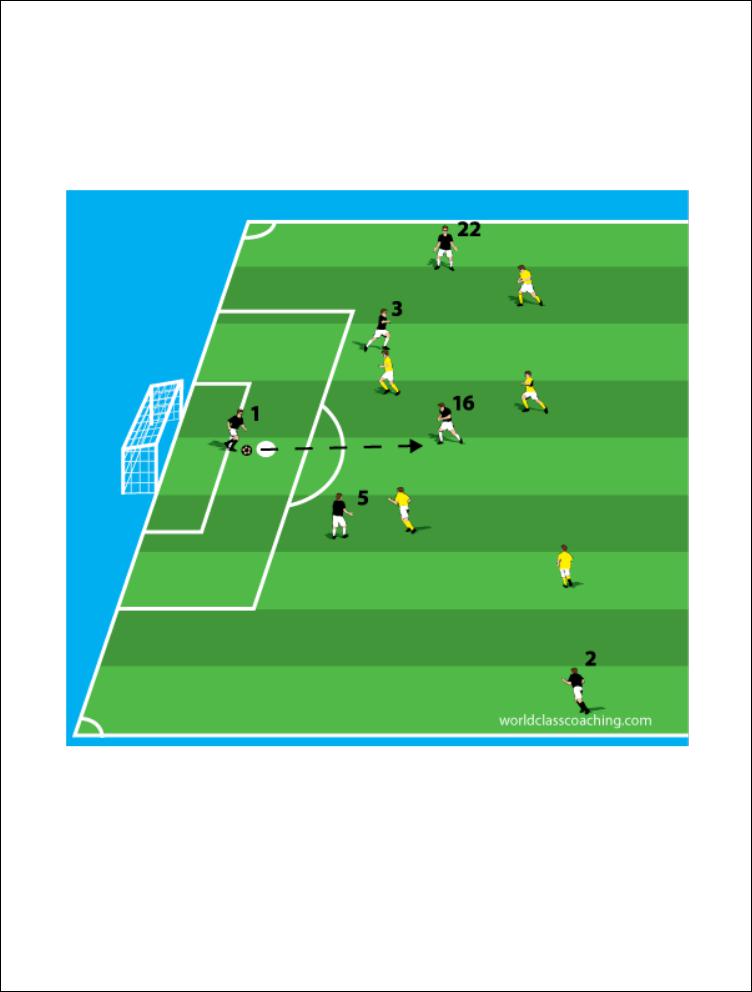
Domination: The Team on the Attack - Patterns, Tendencies and Highlights.
Perhaps the best way to illustrate Barcelona’s attacking is to look at the common patterns of play and also diagram some of the highlights of the 2011-2012 season.
Playing Out of the Back
Barcelona playing out of the back (1) vs. high pressure
Victor Valdes (1) is in possession and despite the opponent applying pressure with five players forward, he refuses to serve the ball up and risk possession on a clearance. The center backs (Pique (3) and Puyol (5)) are in position to either open up or defend if possession is lost. The left back (Abidal (22)) offers a wide outlet, but the right back (Alves (2)) stays high up the pitch, anticipating a breakout. Valdes is comfortable and confident with the ball at his feet and he often looks to Busquets (16) checking in the middle as an outlet. This pass, incidentally, led to an early goal vs. Real Madrid in the first edition of the Classico in 2011-2012, as a turnover caught
©WORLD CLASS COACHING |
Page | 20 |
FC Barcelona – Style and Domination |
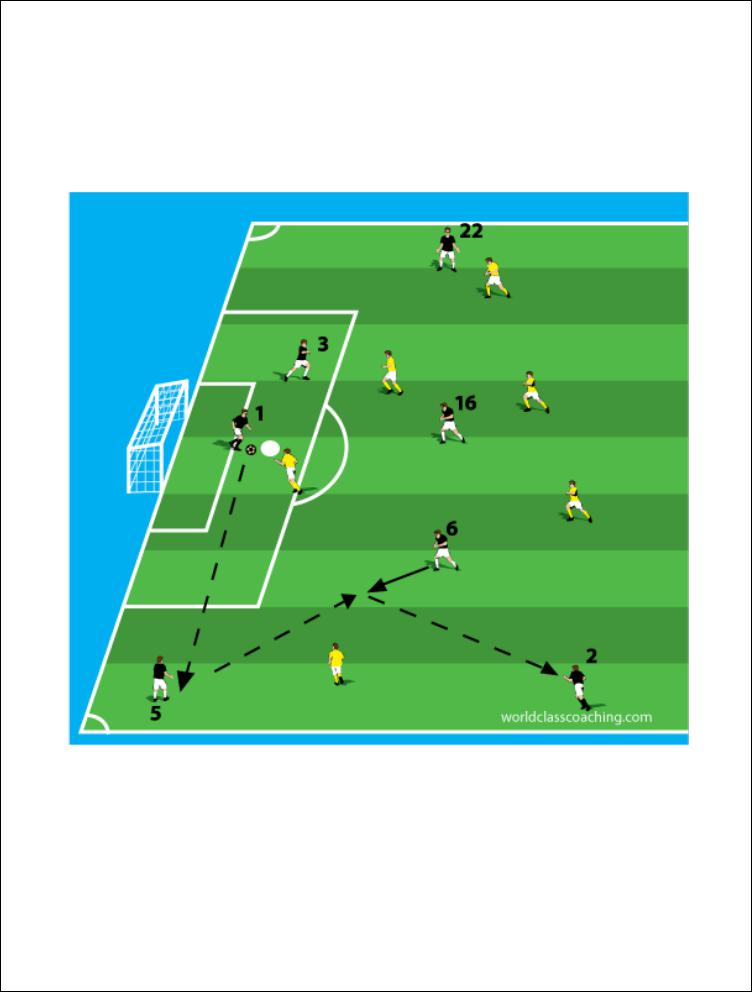
the Barcelona squad too spread out to be able to defend. Not surprisingly, Valdes et al were not deterred, though and continued to knock the ball around in their back third, wearing out Real’s front line and creating space behind them for the Barcelona midfield to exploit. In essence, playing into the midfield triangle immediately allows the team to get the ball onto the feet of the players the team wants to run the game. If Busquets is unable to turn, he typically plays one of the back line players (often Abidal) to open up space and stretch the defense.
Playing out of the back (2) vs. high pressure
Another, more extreme example is shown above. The opponent pushes six players forward, pressing Valdes (1). Logic would certainly dictate playing a ball over the top of the pressing group. However, in a sequence repeated often in La Liga and in Europe, Valdes swings the ball out to Puyol (5). Still, the danger is considerable, as a turnover would find Barca in poor defending shape and Puyol, for all his combative qualities, is not the most gifted passer of the ball. However, the perspective of the Barca players is that a new small-sided game has commenced in the back third and that they need to send help, rather than clear the ball. Thus,
©WORLD CLASS COACHING |
Page | 21 |
FC Barcelona – Style and Domination |
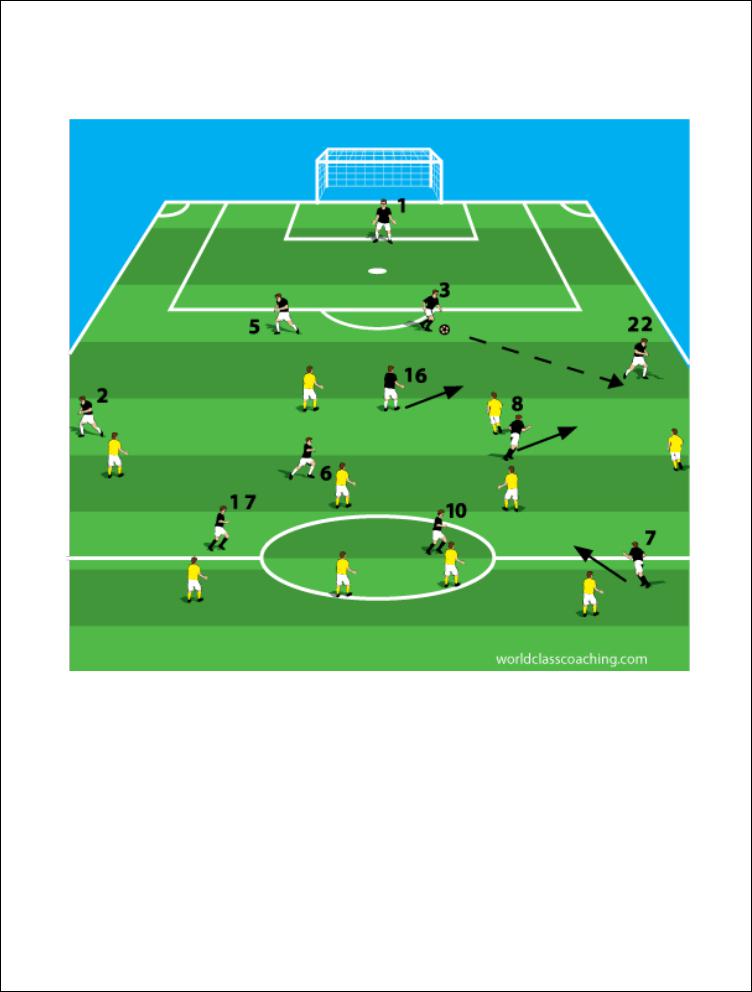
Xavi (6) checks sharply toward Puyol and then plays Alves (2) first-time, and the opponents’ pressure is broken.
Playing out of the back (3) vs. opponent in a block playing delayed high pressure and a high back restraining line.
Many teams try to concede Barcelona’s back third and push their own back line up high, thus condensing play and pressing in the hope of creating turnovers. Here is a typical Barcelona response: Pique (3) plays to Abidal (22) on the flank and the left back dribbles to take available space. Iniesta (8) checks to the ball and Busquets (16) works to get ball-side and underneath in support. Villa (7) also checks into the space in front of the opponents’ back line to be available and free space up the flank if Abidal can get loose or combine to get into space. On the back side of play, Alves (2) often releases very early, and Pedro (17) moves across the formation, dragging and condensing the opponents’ back line and creating a big seam where Alves can work. The general idea against an opponent playing in a block and with a high restraining line is to continue to cycle players to the ball while preparing to quickly exploit the spaces that
©WORLD CLASS COACHING |
Page | 22 |
FC Barcelona – Style and Domination |
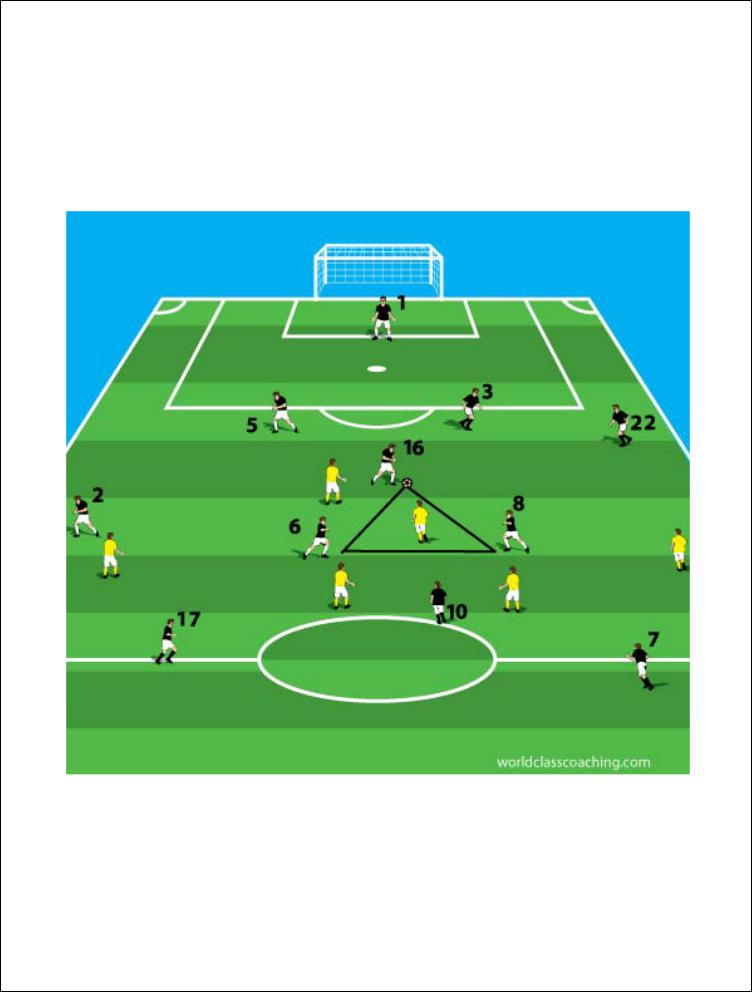
inevitably open as the opposition condense around the ball. Surprisingly, Barca do not often put the ball in behind in this situation, as it would seem likely that Pedro and Messi (and Villa before his injury) would win foot races and score, but it seems to be part of their DNA that Barcelona feel that they can possess and wear down an opponent regardless of that opponents’ ability or tactics.
Running the Middle Third: Barcelona in Possession
The engine: The midfield triangle
Busquets (16), Xavi (6) and Iniesta (8) are, arguably the best midfield triangle in professional soccer (and Cesc Fabregas as an alternate at either of the front points is a remarkable statement of depth).
Xavi Hernandez: The story is that when Guardiola first saw Xavi play, he approached him and told him, ‘You’re going to push me out the door.’ It took a couple years, but as one author
©WORLD CLASS COACHING |
Page | 23 |
FC Barcelona – Style and Domination |

summarized, ‘Xavi incarnates Barcelona soccer.’ He is certainly one of the smoothest, most intelligent midfielders playing the game. When Xavi has the ball, the team appears calm and there is the general consensus that he is nearly perfect in choosing the best pass…and delivering it. He clearly sees the game just as Guardiola wants it played, and he is a stellar, if quiet, leader who sets a terrific example both on the field and off.
Andres Iniesta: When Pep Guardiola first noticed Iniesta, he walked over to Xavi and told him, ‘That guy will send both of us into retirement.’ Both Xavi and Iniesta are Barcelona youth products, raised and socialized at La Masia and like Xavi, the younger Iniesta is, by all accounts, a premier talent.
•Wayne Rooney: ‘(Iniesta is) The best player in the world at the moment.’
•Frank Rijkaard: ‘(He is) A wonderful soccer talent.’
Iniesta often appears to have some sort of other-worldly connection to Xavi, as the two of them are masterful in finding one-another and they seem to live to pass the ball to one-another and their teammates. Both players have tremendous vision, impeccable technical skills and work rates that, together, make them a nightmare to close down.
Sergio Busquets: Certainly the least marquee of the triangle members, Busquets perhaps best incarnates his coach on the field. Though less a leader than Guardiola, Busquets is the right blend of steady and intelligent support player for the creative Xavi and Iniesta and also a bit of a bull when necessary in support of Barcelona’s often widely scattered back line. Busquets is sometimes maligned as soft or being fortunate to play with the two superstars in front of him, but his poise is critical to Barcelona’s possession. His ability to read play and release pressure through being available to change fields leads directly to many of the team’s scoring opportunities. He also has an uncanny knack for cutting out service to opposing strikers and he does a lot of good work filling in on the back line when the team needs an extra player to snuff out counters.
Arrigo Sacchi, the Italian coaching legend, commented that ‘tactics are used to multiply the abilities of the players.’ In the case of the Barcelona triangle, this is a stunning prospect. Tactically, the triangle provides direction and rhythm for the team. Xavi and Iniesta are tireless organizing possession and working back and forth across the field underneath the strikers. Both have the freedom to work into space and create, all the while wearing down their opponents. Busquets, meanwhile, is the pivot player, sitting deep and just above the Barcelona center backs, helping release pressure and change fields.
©WORLD CLASS COACHING |
Page | 24 |
FC Barcelona – Style and Domination |
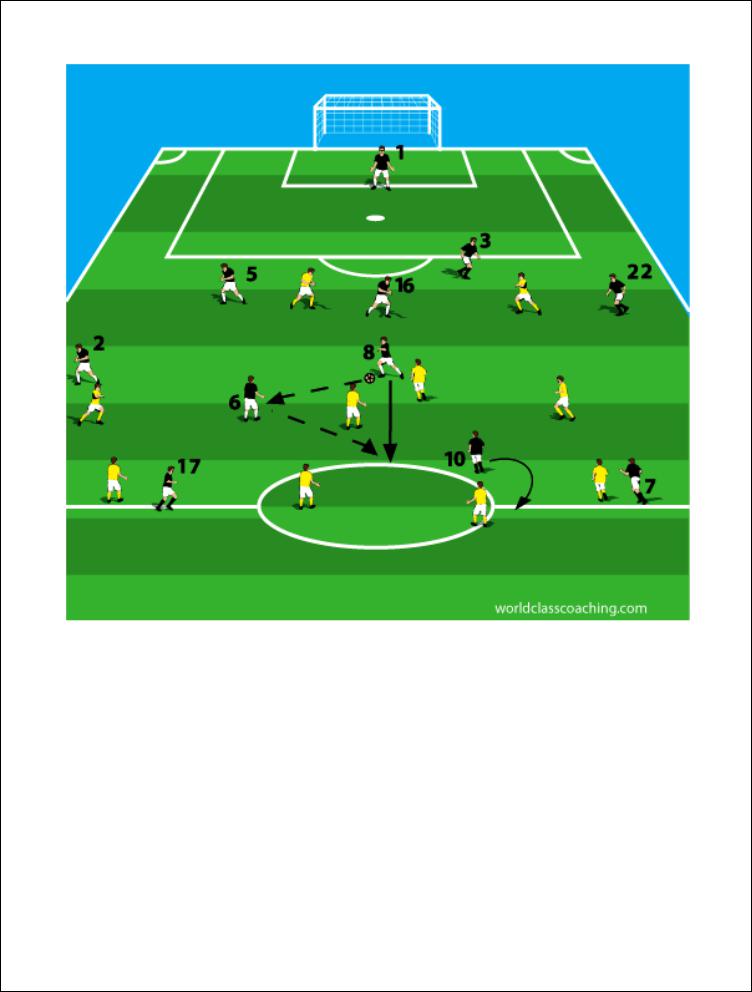
Xavi and Iniesta combine to tear apart central midfield zone
A common site in the run of play for Barcelona is a quick combination between Iniesta (8) and Xavi (6). Here, against a standard midfield zone, Iniesta faces up and plays into Xavi’s feet before splitting two defenders and receiving the return pass from Xavi. The difficulty from a defensive perspective is that if one does not condense the midfield arrangement, Xavi, Iniesta and Busquets (16) will run the game against two central midfielders, and one of theme (Iniesta here) will exploit the horizontal seam between the back line and the midfield. Logically, when one back steps to confront Iniesta, he will put in one of the three forwards and the defense is left with, at best, a 1 vs. 1 against quick, talented attackers who revel in such opportunities.
Conversely, if the midfield zone is condensed, Abidal (22) and Alves (2) will be free to operate on the flank.
©WORLD CLASS COACHING |
Page | 25 |
FC Barcelona – Style and Domination |

Busquets as the pivot; Xavi and Iniesta stretch the opposing midfield
As talented as the Barcelona triangle are, it is critical to emphasize that their abilities are multiplied by the team’s tactics. Because Guardiola has built a team of ‘midfielders’ and wants the team to consistently play through and in the triangle, Xavi, Iniesta and Busquets get lots of touches and time on the ball. The system is also designed to accentuate the midfielders’ talent in that the team is organized and populated to allow virtually all of the other field players to cycle through the midfield. Messi, Alves, Pedro, Villa, Abidal, and even Piquet and Puyol ghost into the midfield over the course of a game. As they do, they provide options for the midfield triangle to stretch and wear down their opponents, and they make marking the midfield triangle much more difficult.
©WORLD CLASS COACHING |
Page | 26 |
FC Barcelona – Style and Domination |
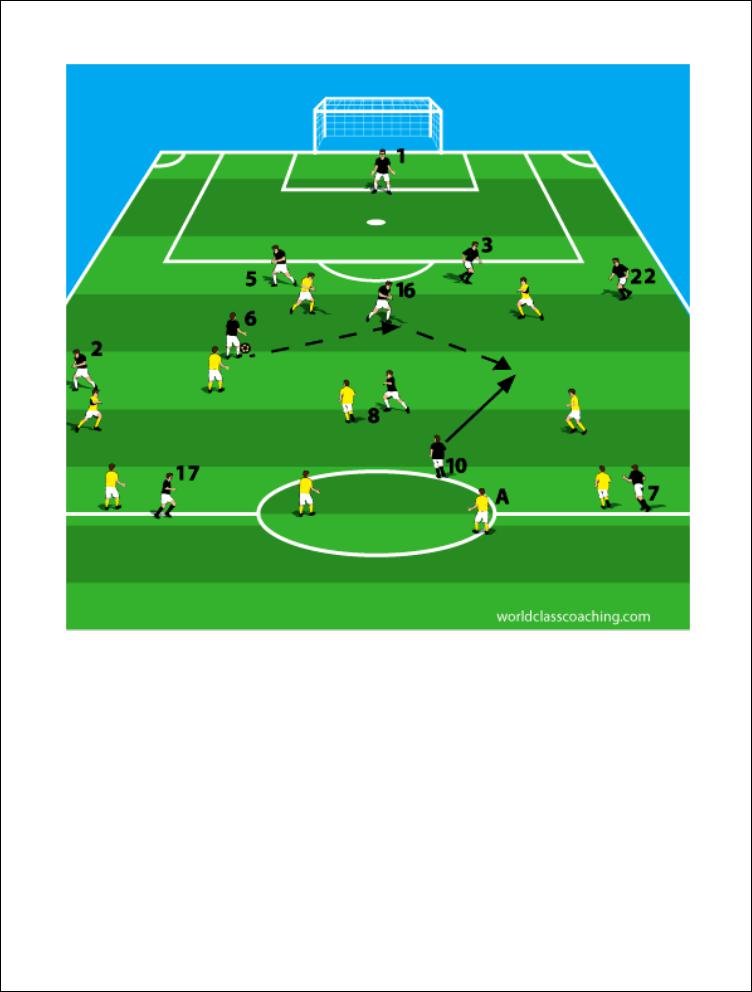
Busquets as the pivot; Messi (‘false 9’) checks into midfield to break pressure
Here, Xavi (6) is being pressed and opposition have done a good job of compressing space in the midfield. To break the pressure, Busquets (16) steps forward to receive Xavi’s pass. Meanwhile, Messi (10) checks sharply into back-side space in the midfield, creating an overload situation (Alves (2), Busquets (16), Xavi (6), Iniesta (8) and Messi(10) vs. four defender)s. This move creates further dilemmas for the opposition in that if defender A follows Messi into the midfield, the back line is stretched and Villa (7) and Pedro (17) have large spaces into which they can run. Abidal (22) is also a threat to get loose on the flank in this situation, or to join the midfield possession phase if he wishes, further confounding the opponents’ midfield marking.
©WORLD CLASS COACHING |
Page | 27 |
FC Barcelona – Style and Domination |
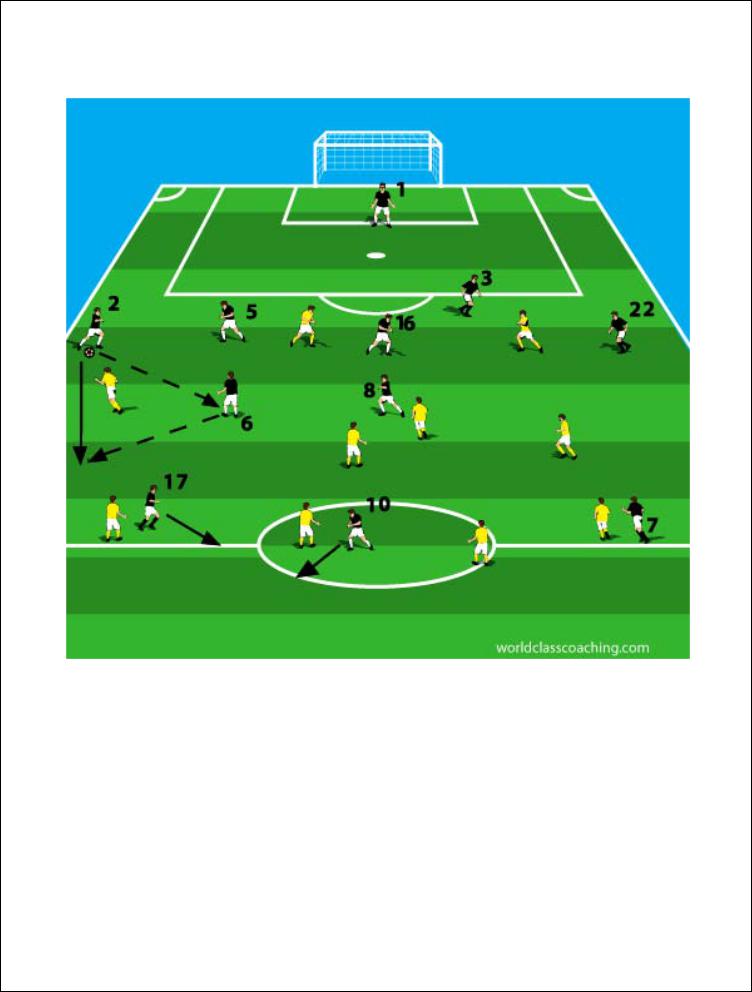
Flank Transition in the Middle Third
Flank transition: Overlapping the outside back
This move is a staple in most 4-3-3 formations given the open space on the flanks in the midfield. Alves (2) plays in the feet of Xavi (6) and then gets wide and behind the opposing midfield player as Xavi returns the pass, completing the 1-2. Abidal (22) frequently completes the same sequence on the other side of the field. When the outside back gets loose on the flank, the situation becomes very difficult for the opposing back line. Pedro (17) tends to push inside, either dragging the opposing outside back with him or bending his run back to the flank and in behind if the back does not chase him. Messi (10), meanwhile, often makes an angled run ballside that is very difficult for the near-side center back to pick up and track because it happens in his blind spot if he’s watching the ball.
©WORLD CLASS COACHING |
Page | 28 |
FC Barcelona – Style and Domination |
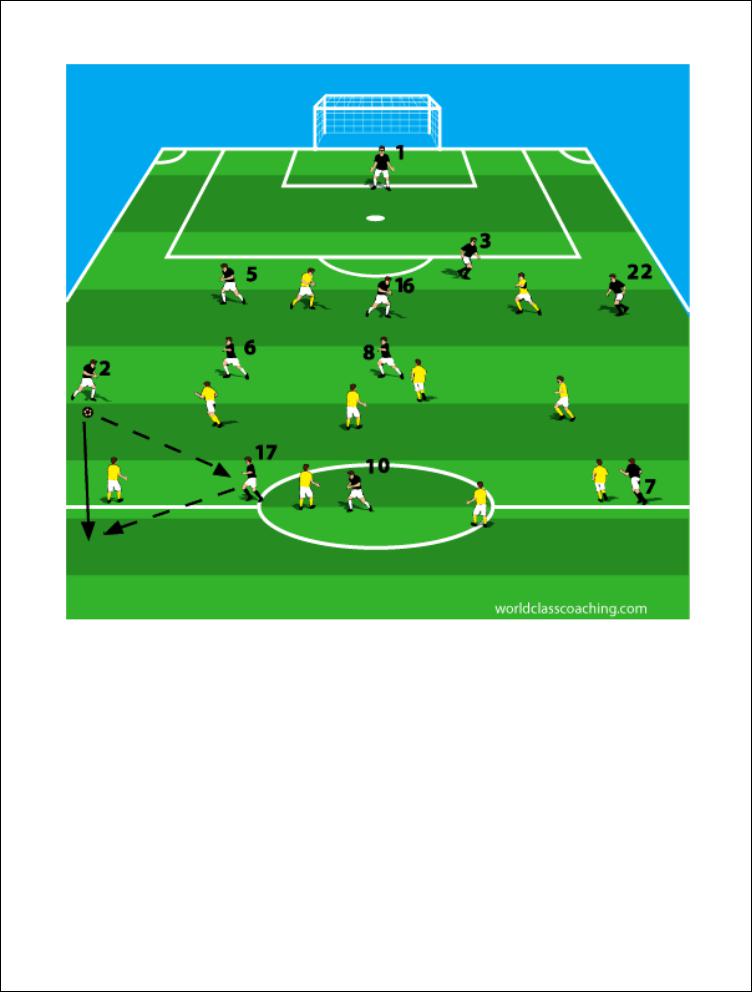
Flank transition: 1-2 with the forward to get the outside back in.
This sequence could happen immediately following the previous move or build out of a change of fields. Alves (2) is in space on the flank and running at the outside back. Pedro (17) has run inside to expand the space for Alves to work in. He then shows to the ball and completes a 1-2, freeing Alves to penetrate on the dribble. Xavi (6) is in good position to get underneath Alves’ run in support and Messi (10) and Villa (7) prepare to get in behind as well. As dominant as Barcelona are in the central areas of the field, much of the possession there, by drawing in defenders and wearing down the defense, sets up runs similar to this one on the flank.
©WORLD CLASS COACHING |
Page | 29 |
FC Barcelona – Style and Domination |
